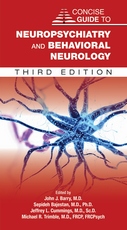Developmental Psychopathology and Wellness
Genetic and Environmental Influences
View Pricing
Description
A major benchmark in the understanding of psychiatric illness in children and adolescents, Developmental Psychopathology and Wellness reports on progress in identifying genetic and environmental influences on emotional-behavioral disorders. A team of 22 international authorities presents work that changes the way child psychiatry and clinical psychology are conceptualized, debunking misconceptions about depression, antisocial behavior, and other conditions to enhance our understanding of the causes of child psychopathology—and improve the ways we treat these disorders.
Coverage of basic principles describes the influence of genomic medicine, as explained by trailblazers in the field who demonstrate the importance of the developmental perspective. Chapters on gene-environment interaction review the important concepts of personality and temperament, cognition, and sex—including findings from molecular genetic investigations on adolescent cognition, temperament, and brain function. Disorder-based examples show how emotional-behavioral illness and wellness attest to the interaction of genetic and environmental factors over time, providing new insight into the study of anxious depression, ADHD, autism, and antisocial personality disorders. And in considering how we can bridge the gap between research and clinical applications, Dr. Hudziak describes his family-based gene-environment approach as a means of better understanding etiopathology and treatment. Among the other significant contributions:
- Thomas Achenbach focuses on the importance of culture in understanding the genetic and environmental impact on children, with insights into measuring these sources of influence.
- Joan Kaufman reports on her seminal work on the genetic and environmental modifiers of risk and resilience in child abuse, relating maltreatment to other forms of environmental risk, genetic mediation, and reactivity.
- D. I. Boomsma describes the genetic architecture of childhood worry, presenting data from an extraordinary sample of 30,000 twin pairs.
- Frank Verhulst draws on a 14-year study to detail the advantages of the developmental perspective in understanding antisocial behavior.
- Stephen Faraone offers guidelines for moving beyond statistics to document the functional significance of DNA variants associated with psychopathology.
As the contributors ably demonstrate, these new approaches to the care and treatment of at-risk children are applicable to daily practice, teaching, and research. Developmental Psychopathology and Wellness shows that these psychopathologies are not a matter of nature versus nurture or genes versus environment, but rather an intertwining web of them all.
Contents
- Contributors
- Preface
- Part 1: BASIC PRINCIPLES OF DEVELOPMENTAL PSYCHOPATHOLOGY
- Chapter 1. Developing Concepts in Developmental Psychopathology
- Chapter 2. Multicultural Perspectives on Developmental Psychopathology
- Chapter 3. Social Context and Developmental Psychopathology
- Part 2: GENERAL CONCEPTS OF GENE–ENVIRONMENT INTERACTION ON CHILD DEVELOPMENT
- Chapter 4. Temperament and Child Psychopathology: Beyond Associations
- Chapter 5. Genetics of Personality and Cognition in Adolescents
- Chapter 6. Sex and Developmental Psychopathology
- Part 3: DISORDER-BASED EXAMPLES OF THE STUDY OF GENE–ENVIRONMENT INTERACTION
- Chapter 7. Genetic and Environmental Modifiers of Risk and Resiliency in Maltreated Children
- Chapter 8. Genetic and Environmental Influences on Anxious/Depression: A Longitudinal Study in 3- to 12-Year-Old Children
- Chapter 9. Intersection of Autism and ADHD: Evidence for a Distinct Syndrome Influenced by Genes and by Gene–Environment Interactions
- Chapter 10. Genetic Epidemiology of Pervasive Developmental Disorders
- Chapter 11. The Fourteen-Year Prediction of Antisocial Behavior
- Part 4: THE FUTURE OF THE STUDY OF DEVELOPMENTAL PSYCHOPATHOLOGY IN GENETICS AND CLINICAL SETTINGS
- Chapter 12. Statistical and Molecular Genetic Approaches to Developmental Psychopathology: The Pathway Forward
- Chapter 13. Genetic and Environmental Influences on Wellness, Resilience, and Psychopathology: A Family-Based Approach for Promotion, Prevention, and Intervention
- Index
Contributors
- Thomas M. Achenbach, Ph.D.
Adrian Angold, M.R.C.Psych.
Meike Bartels, Ph.D.
Dorret I. Boomsma, Ph.D.
John N. Constantino, M.D.
Stephen V. Faraone, Ph.D.
Nathan A. Gillespie, Ph.D.
James J. Hudziak, M.D.
Joan Kaufman, Ph.D.
Michelle Luciano, Ph.D.
Dana March, M.P.H.
Nicholas G. Martin, Ph.D.
Rosalind J. Neuman, Ph.D.
Wendy Reich, Ph.D.
Angela M. Reiersen, M.D., M.P.E.
David C. Rettew, M.D.
Michael Rutter, M.D.
Ezra Susser, M.D., Dr.P.H.
Richard D. Todd, Ph.D., M.D.
C.E.M. van Beijsterveldt, Ph.D.
Frank C. Verhulst, M.D.
Heather E. Volk, Ph.D., M.P.H.
Margaret J. Wright, Ph.D.
Gu Zhu, M.P.H., M.D.
About the Authors
James J. Hudziak, M.D., is Professor in the Departments of Psychiatry, Medicine, and Pediatrics; Thomas M. Achenbach Chair in Developmental Psychopathology; and Director of the Vermont Center for Children, Youth, and Families at the University of Vermont College of Medicine in Burlington, Vermont. He is also Professor and Endowed Chair on Genetics of Childhood Behaviour Problems, Biological Psychology, at Vrije Universiteit in Amsterdam, The Netherlands, and Adjunct Professor of Psychiatry at Dartmouth School of Medicine in Hanover, New Hampshire.
Related Products
Carousel Control - items will scroll by tabbing through them, otherwise arrows can be used to scroll one item at a time








